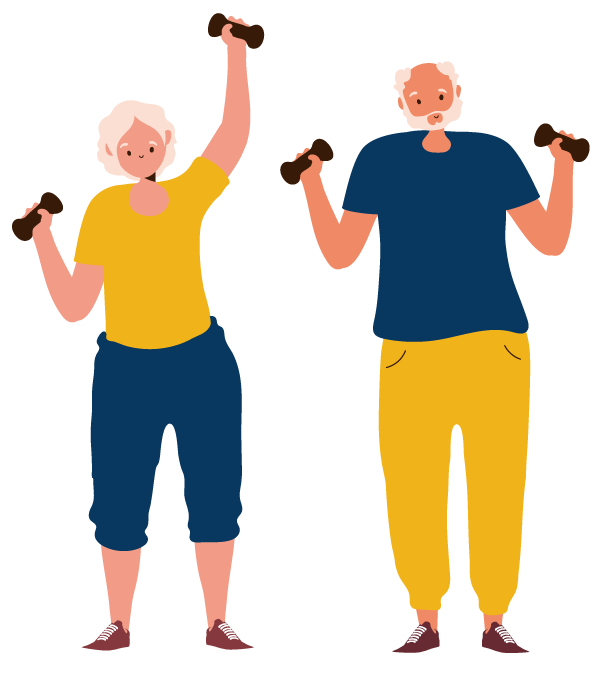Healthy Lifestyle
Exercise Programme for Older Adults
When you create an exercise plan, you should
- Choose activities based on your personal interest to stay motivated
- Consider your physical fitness, health condition, exercise intensity, and risk of falling
- Begin with low intensity level activities, and gradually increase the intensity to moderate and vigorous if possible
Precautions
If you have chronic diseases, you could design an exercise schedule based on therapeutic and preventative effect
For example, if you have osteoporosis, flexibility and balance activities are encouraged. Weight-bearing aerobic activities are also important in slowing down bone loss. If you have chronic knee pain, heavy weight-bearing activities and squat exercises should be avoided and be replaced with aqua-aerobics and Tai chi exercises. If you have cardiovascular conditions and/or diabetes mellitus, you could consult health professionals for advice in advance.
Recommended amount of exercise for older adults
Aerobic activity
According to the World Health Organization (WHO) guidelines, it is recommended that older adults should do:
- Moderate intensity aerobic activities: at least 150 – 300 minutes (2 hours 30 minutes to 5 hours) per week;
- E.g. 5 days per week, 30 – 60 minutes per day (in bouts of at least 10 minutes); OR
- Vigorous intensity aerobic activities: at least 75 – 150 minutes (1hours 15 minutes to 2hours 30 minutes) per week
E.g. 3 days or above per week, 20 – 30 minutes per day (in bouts of at least 10 minutes); OR
- An equivalent combination of moderate- and vigorous intensity activity throughout the week.
Muscle-strengthening
- At least 2 days per week, in bouts of at least 10 minutes involving 8-10 types of major muscle group movement; 8-12 repetitions are counted as one set and 2 to 3 sets are recommended for each practice.
- Example: Lifting a water bottle while sitting on a chair. Hold a plastic bottle containing about 500ml of water with your right hand. Raise your right arm and keep it straight. Return slowly to the starting position. Perform 10 times with each arm.
- Begin with low-intensity level, gradually move to moderate and vigorous level.
Balance
- At least 2 days per week, in bouts of at least 20-30 minutes including static and dynamic activities.
- Example: Stand firm on your right leg. Lift your left leg about 2 inches from the floor and hold for 5-10 seconds before returning to starting position. Repeat the exercise with the other leg. Perform 2-3 times with each leg.
Flexibility
- At least 2 days per week, hold 30-60 seconds and repeat 1 – 2 times for each movement.
- Example: Rest your left hand on your right shoulder. Hold your left elbow with your right hand and pull it toward your body for 30 -60 seconds. Return to the starting position. Repeat with your right arm.
Older people who are unable to complete the recommended exercise due to health reasons should do as much as possible within the scope of their ability and condition.

Exercise Precautions
- Do sufficient warm-up and cool-down exercises before and after each physical activity.
- If you feel discomfort, stop the exercise immediately and rest in a safe place, and seek help from family, friends, medical staff, physiotherapists, qualified fitness coaches and other professionals when necessary.
- If you are experiencing the following conditions, you may consult your family doctor or physiotherapists before doing exercise:
- Chronic illness (e.g. heart disease, hypertension, diabetes mellitus)
- High fall risks or history of frequent falls
- Suffering from diseases that may affect balance (e.g. stroke, Parkinson’s disease)
- Severe joint pain (e.g. arthritis, sciatica)
Exercise Tips for Older Adults
- Safety is the primary consideration during exercise; you also need to pay attention to avoid doing excessive amount of exercise.
- Doing some physical activity is better than doing none. Compared to not having any exercise habits, doing the lightest activities is the first step to success.
- Start with reducing the amount of sedentary time. Example: Stand up from seated position and drink water every 30 minutes is better than sitting all day watching TV.
- Step by step: older adults should start by doing a small amount of physical activity, and gradually increase the frequency, intensity and duration over time.
- Incorporate some physical activities into your daily routines. For example:
- Taking the stairs instead of an elevator or escalator.
- Getting off one station earlier and walk back home.
- Walking or biking instead of driving or taking public transport.
- Walking your dog.
- Doing light exercises while watching TV.
- Doing exercises with a close friend together, so you can both have fun and take care of each other.
